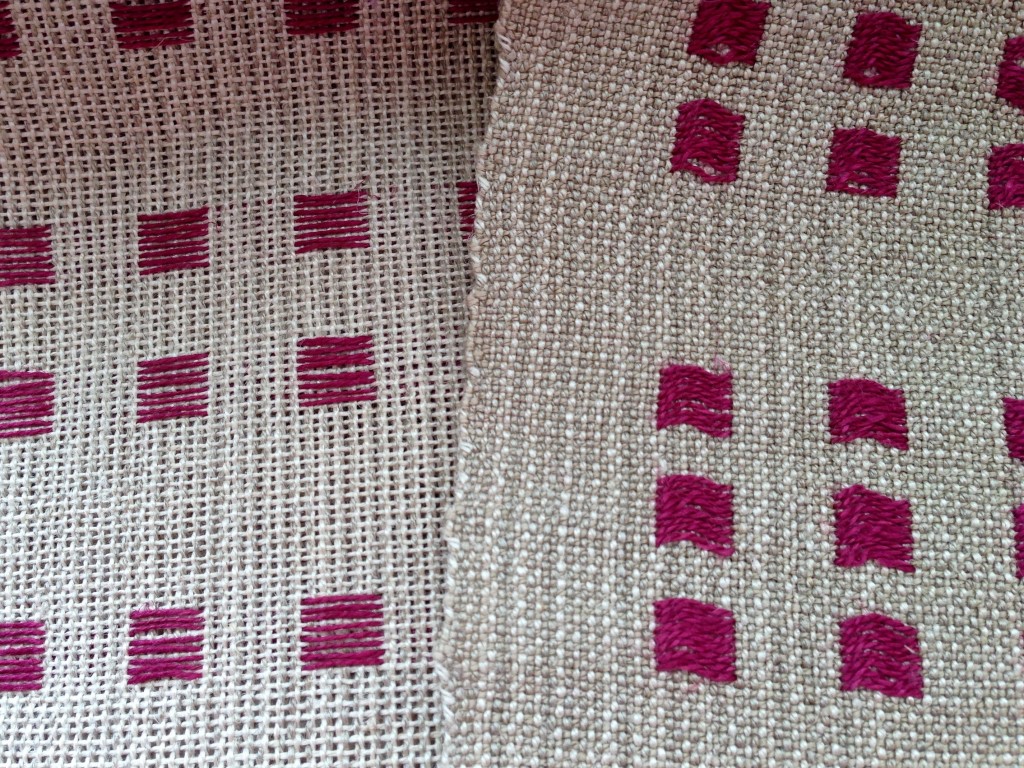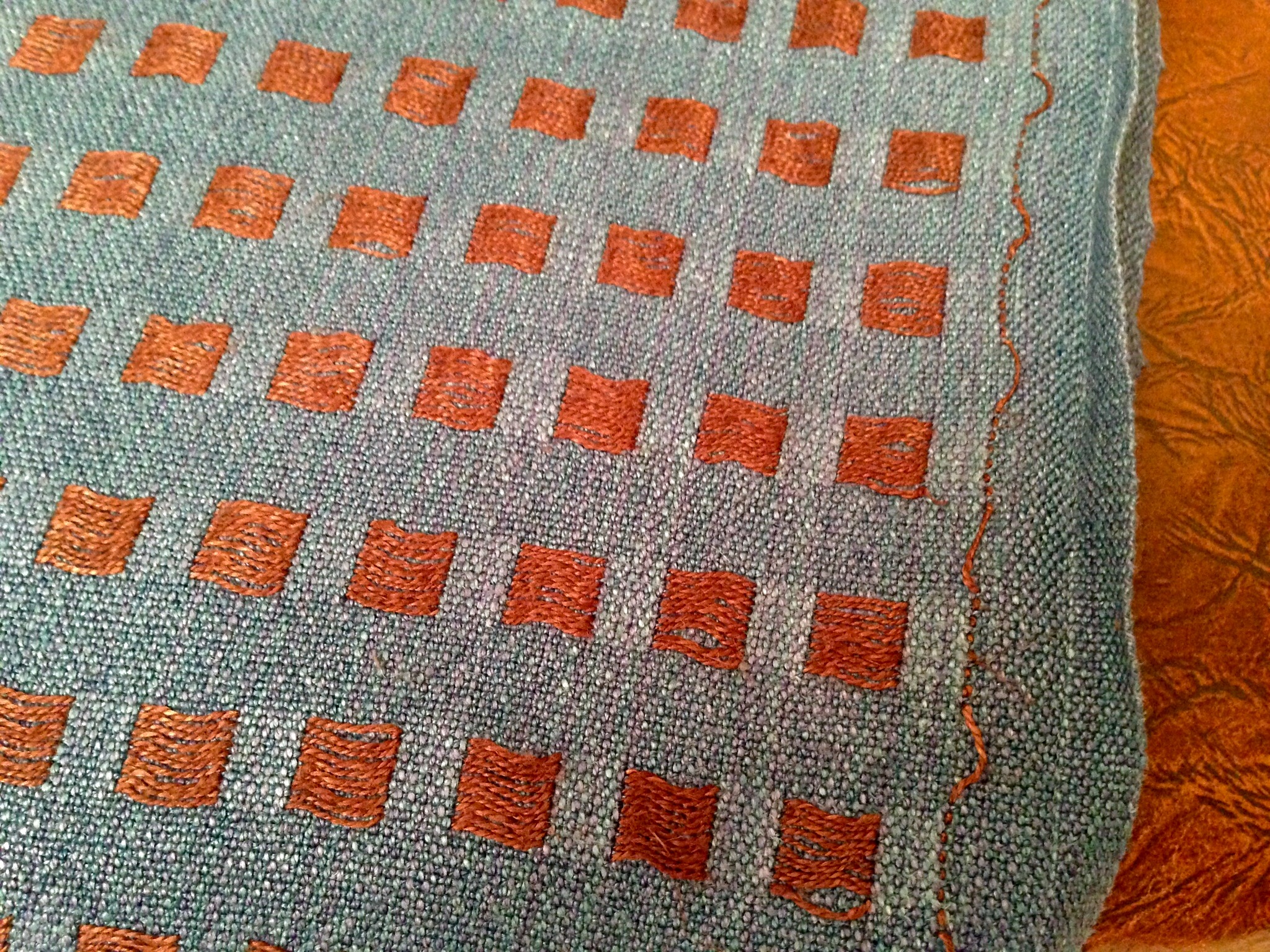It is time for wet finishing. As curious as I am to see how the linen fabric will emerge through the process, I still hesitate when it is time to put the fabric in the water. Fresh off the loom, the fabric is coarse and stiff, but it looks good! I know that the water, mild soap, and gentle washing machine agitation will absolutely change the character of the cloth. Wet finishing should change the cloth for the better… Finally, I look at my notes again from the wet finished sample piece, and gain the courage to put the linen fabric in the water…

Don’t hesitate to pray. Seek God when things are calm. Today is the best time to pray, when things are going well. Oh yes, there may be changes as a result of your prayers, but the changes are all good.
May you see the positive changes you hope for.
With anticipation,
Karen

I like the dice weave; so clean! Was the linen really difficult, or have you used it before. I used cottolin once; it seemed too stay quite stiff.
Fran, Yes, that’s one thing I like about the dice weave, too – it is clean and uncluttered. Linen does require some extra attention for weaving, but I wouldn’t say it’s difficult. I have used linen before, and each time it seems to get easier. Now, I really enjoy weaving with linen, and I love the results. My cottolin towels get softer and softer with use and repeated laundering. They are my favorite towels.
Karen
can you share the threading instructions for the dice weave? it’s fascinating. in my mind i’d put on a supplementary warp. it appears you do the dice as wefts. please share.
thanks
maggie
Hi Maggie,
Dice weave is actually a simplified monk’s belt weave. I used the draft in “The Big Book of Weaving,” by Laila Lundell, p.128. This is pattern weft on a plain weave background, and uses only three treadles–two treadles for the plain weave and one treadle for the pattern. There are two blocks, with block 1 threaded on the first 2 shafts – 1212, and block 2 threaded on the remaining 2 shafts – 3434. It’s that simple. If you look at the draft in the book, you will see how minimal it is.
Happy Weaving,
Karen
may we see the back? are the floats longer? do they tie into the salvage on the sides or do you actually turn at the last dot on the rt and Lt? If you added a 4th harness the purple dot weft could be carried without floats on the back. plain weave on 1&2, dots on #3 and #4 would be the tiedown paired up with 1 or 2, but then the background would have a speckled effect. let me think on this. The best part of weaving is the puzzle of making it work. PLJ, linda
Linda, the floats are a little longer on the back; and the pattern weft does enter and exit through a plain weave shed at the selvedge. Here’s a picture of the back of the blue and brown dice weave that I did previously. It’s not a great picture, but it allows you to see the back.

Karen, I would love to know who you wet finished the linen. Did you soak it before washing? did you then use the washing machine? what temperature did you wash it at? Did you dry it flat? did you iron it?
There’s so much contradictory advice out there, I don’t know which way to jump. I hope you can make some suggestions.
many thanks,
Julia
Hi Julia, My standard process for washing linen handwoven fabric is to fill the washing machine with cool to warm water, add a small amount of Eucalan (a gentle wash). Add the linen fabric and let it gradually get saturated – let it sit on the water for a while, until it starts to sink down in the water. If there is any color in the linen I add one or two Color Catchers. I set the washing machine on gentle wash, short cycle, cool, and low or no spin. Then, I roll the fabric in a terry towel and let air dry. I lay the linen flat to dry if it’s small enough, or hang it over a pvc pipe if it’s too large to lay flat. If you can lay flat on a hard, non-porous surface, like a kitchen countertop, it won’t usually need pressing. Just turn it over a couple times as it is drying.
Depending on the article, after that first wash, I am much more inclined to machine wash and dry the linen fabric. For towels, they go in my regular towel laundry. For table runners or more decorative pieces, if they need laundering, I treat them much more delicately, and wash and dry similar to the first careful washing.
I hope that gives you some ideas. You have to finally just dive in, knowing that you could make a mistake. If you do, you will learn from it and know what NOT to do next time. It’s all a fun learning journey.
Happy Weaving,
Karen